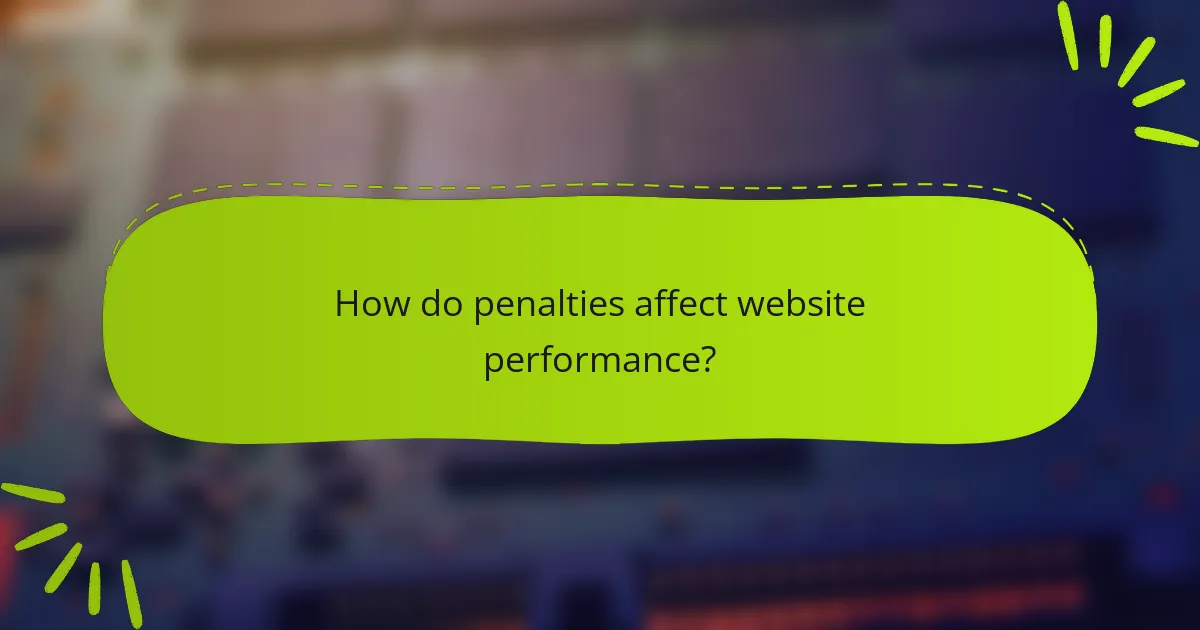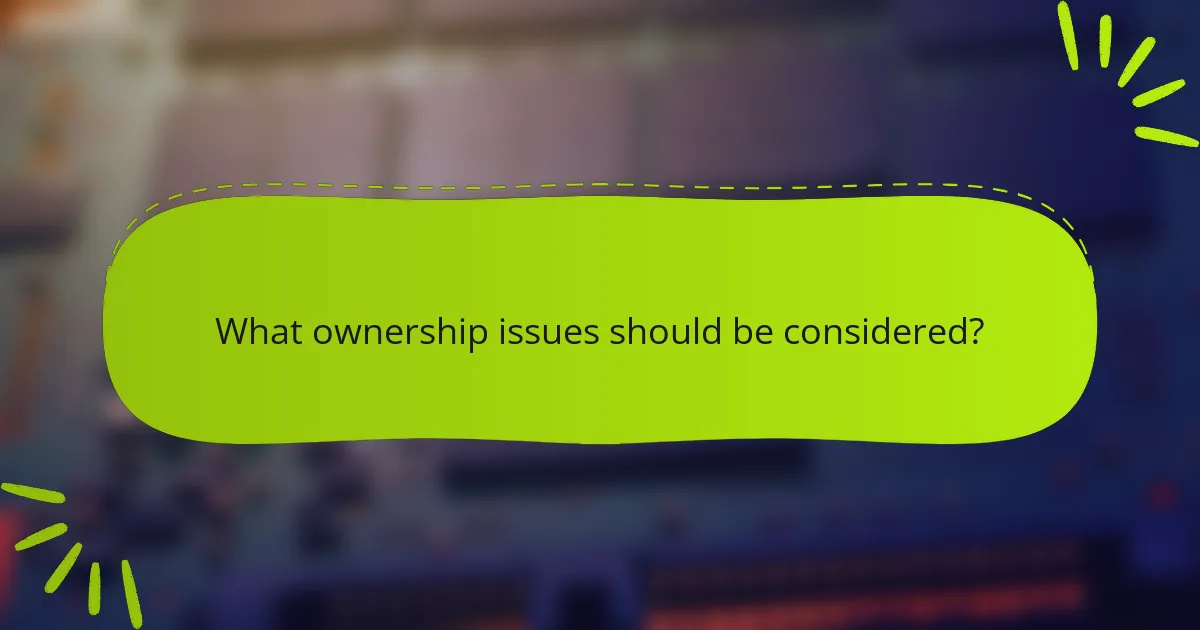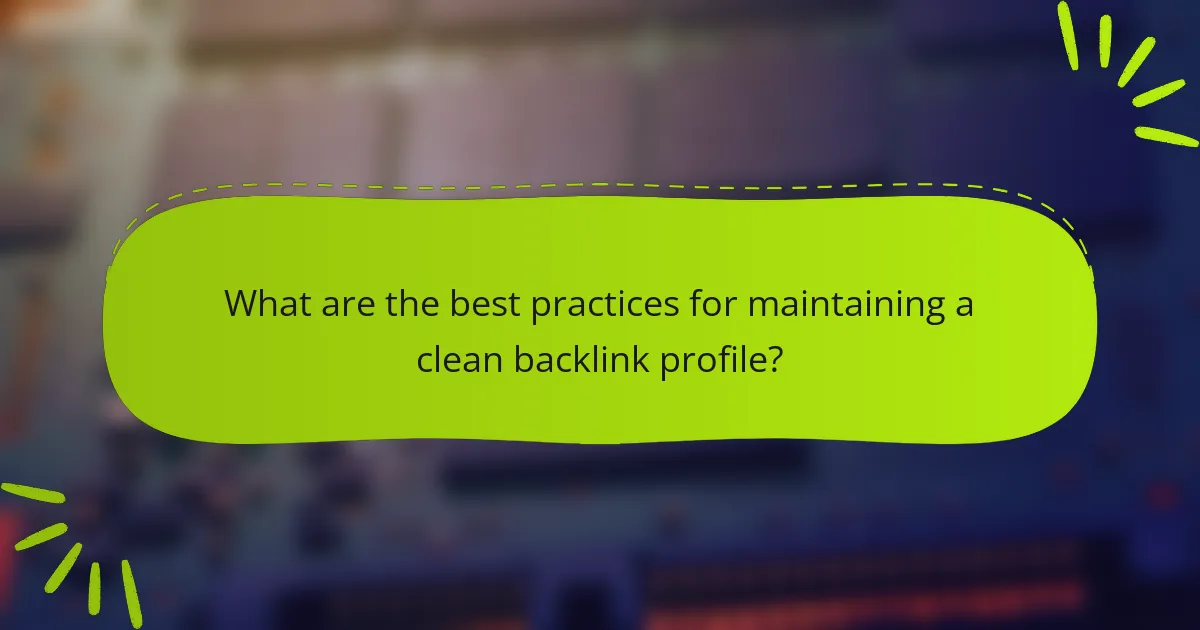Understanding the red flags associated with spam history, penalties, and ownership issues is crucial for maintaining a credible online presence. Indicators such as frequent domain changes and negative user reviews can signal potential trustworthiness problems, while penalties from search engines can severely impact visibility and traffic. Additionally, ensuring proper ownership of domains and content is essential to avoid legal disputes and ensure ethical management.

What are the red flags of spam history in websites?
Red flags of spam history in websites can indicate potential issues with credibility and trustworthiness. Key indicators include frequent domain changes, high spam scores, negative user reviews, blacklisted domains, and low-quality backlinks.
Frequent domain changes
Websites that frequently change their domain names may be attempting to evade penalties or negative reputations. This behavior can signal instability and a lack of commitment to quality content, which can deter users and search engines alike.
To assess domain stability, check the registration history using tools like WHOIS. A site that has changed domains multiple times in a short period should raise concerns about its legitimacy.
High spam score
A high spam score, often assessed by tools like Moz or SEMrush, indicates a greater likelihood that a website engages in spammy practices. Scores above a certain threshold, typically around 5-10%, suggest potential issues that could affect search engine rankings.
Regularly monitor your site’s spam score and address any issues that contribute to it. This may involve cleaning up backlinks or improving content quality to enhance your site’s reputation.
Negative user reviews
Negative user reviews can significantly impact a website’s credibility. If users consistently report spammy behavior or poor experiences, it can lead to a tarnished reputation and decreased traffic.
Encourage satisfied users to leave positive feedback and promptly address any complaints. Monitoring platforms like Trustpilot or Google Reviews can help you stay informed about public perception.
Blacklisted domains
Being associated with blacklisted domains can severely harm a website’s reputation. If your site links to or is linked from domains that are on spam blacklists, it may also be flagged by search engines.
Regularly check your backlinks and disavow any that come from blacklisted sources. Tools like Google Search Console can help identify problematic links that need attention.
Low-quality backlinks
Low-quality backlinks, often from irrelevant or spammy sites, can negatively impact your website’s authority and search rankings. A diverse and high-quality backlink profile is essential for maintaining credibility.
Use backlink analysis tools to evaluate the quality of your incoming links. Aim for backlinks from reputable sources, and consider removing or disavowing low-quality links to improve your site’s standing.

How do penalties affect website performance?
Penalties can significantly hinder website performance by reducing visibility and traffic. These penalties often stem from violations of search engine guidelines, leading to various negative outcomes for website owners.
Decreased organic traffic
When a website receives a penalty, it typically experiences a sharp decline in organic traffic. This decrease occurs because search engines may demote the site in search results, making it less visible to potential visitors.
For example, a site that previously received hundreds of visitors daily may see that number drop to just a handful. This loss can severely impact overall engagement and conversions.
Lower search engine rankings
Penalties can lead to lower search engine rankings, which directly affects a website’s ability to attract visitors. Search engines prioritize sites that comply with their guidelines, so those with penalties may find themselves buried on results pages.
As a result, even if a website has quality content, it may struggle to rank well, leading to fewer clicks and reduced credibility among users. Regularly monitoring rankings can help identify issues early.
Loss of advertising revenue
With decreased traffic and lower rankings, websites often face a significant drop in advertising revenue. Many online businesses rely on ad placements for income, and penalties can reduce the number of impressions and clicks on these ads.
For instance, a website that previously earned several hundred dollars a month from ads may see that revenue cut in half or more after a penalty. To mitigate this, website owners should focus on compliance and regularly audit their practices to avoid penalties.

What ownership issues should be considered?
Ownership issues are critical in ensuring that a domain or content is legally and ethically managed. Key considerations include verifying ownership claims, understanding the process for transferring domain ownership, and being aware of potential legal disputes over content rights.
Unverified ownership claims
Unverified ownership claims can lead to significant complications, including potential legal challenges. It’s essential to confirm that the individual or entity asserting ownership has the proper documentation, such as registration records or transfer agreements. Always check domain registration databases and public records to validate claims.
Common pitfalls include relying solely on verbal assertions or incomplete documentation. To avoid issues, request official proof of ownership and consider using services that specialize in verifying domain ownership.
Transfer of domain ownership
Transferring domain ownership involves a formal process that typically requires both parties to agree and complete specific steps. This process often includes unlocking the domain, obtaining an authorization code, and updating the registration information with the domain registrar. Each registrar may have different requirements, so it’s crucial to follow their guidelines closely.
Consider potential fees associated with the transfer and the time it may take to complete. Transfers can take anywhere from a few hours to several days, depending on the registrar’s policies and the responsiveness of both parties.
Legal disputes over content
Legal disputes over content can arise from copyright infringement, trademark issues, or unauthorized use of materials. It’s vital to ensure that all content used is either owned, licensed, or falls under fair use provisions. Regular audits of content can help identify potential risks.
If a dispute arises, having clear documentation of ownership and usage rights is crucial. Engaging legal counsel familiar with intellectual property law can provide guidance on resolving conflicts and protecting your rights effectively.

How to identify spammy backlinks?
Identifying spammy backlinks involves assessing the quality and relevance of links pointing to your site. Poor-quality backlinks can harm your website’s reputation and search engine rankings, so it’s crucial to analyze them effectively.
Use of backlink analysis tools
Backlink analysis tools are essential for identifying spammy links. Tools like Ahrefs, SEMrush, and Moz can help you evaluate your backlink profile by providing insights into link quality, anchor text distribution, and referring domains.
When using these tools, focus on metrics such as spam score, link type, and the overall health of the linking domains. Regularly auditing your backlinks with these tools can help you catch potential issues early.
Checking domain authority
Domain authority (DA) is a metric that indicates the strength of a website’s backlink profile. A low DA score, especially below 20, can suggest that a site is spammy or of low quality.
To check domain authority, use tools like Moz or Ahrefs. If you find backlinks from sites with low DA, consider disavowing those links to protect your own site’s credibility.
Identifying link patterns
Analyzing link patterns can reveal spammy backlinks. Look for unnatural link-building tactics, such as excessive links from a single domain or irrelevant niche sites. A sudden spike in backlinks can also indicate a spammy link scheme.
Common patterns to watch for include links with generic anchor text, links from unrelated industries, and links that appear in bulk over a short period. Identifying these patterns can help you take action against harmful backlinks effectively.

What are the best practices for maintaining a clean backlink profile?
Maintaining a clean backlink profile involves regularly monitoring your links, removing harmful ones, and focusing on acquiring high-quality backlinks. These practices help improve your website’s authority and search engine rankings while minimizing the risk of penalties.
Regular backlink audits
Conducting regular backlink audits is essential for identifying and assessing the quality of your backlinks. Aim to perform these audits at least quarterly to ensure that your profile remains healthy and free from spammy links.
During an audit, use tools like Google Search Console or third-party SEO software to analyze your backlinks. Look for patterns such as low domain authority or irrelevant sources that could harm your site’s reputation.
Disavowing harmful links
If you discover harmful links during your audit, disavowing them is crucial. This process involves informing search engines that you do not want these links to be considered when assessing your site’s authority.
To disavow links, create a text file listing the URLs or domains you wish to exclude and submit it through Google’s Disavow Tool. Be cautious, as disavowing legitimate links can negatively impact your SEO efforts.
Building high-quality backlinks
Focusing on building high-quality backlinks is vital for a strong backlink profile. Aim for links from reputable websites within your industry, as these can significantly enhance your site’s credibility.
Strategies for acquiring quality backlinks include guest blogging, creating shareable content, and networking with industry influencers. Prioritize relevance and authority over quantity to ensure that your backlink profile remains robust and beneficial.

What tools can help monitor spam history?
Monitoring spam history is crucial for maintaining a website’s reputation and avoiding penalties. Several tools can assist in tracking backlinks, identifying spammy domains, and analyzing overall link health.
Ahrefs for backlink analysis
Ahrefs is a powerful tool that provides comprehensive backlink analysis, allowing users to assess their link profile and identify potentially harmful links. By entering a domain into Ahrefs, you can view metrics such as the number of backlinks, referring domains, and the overall domain rating.
To effectively monitor spam history with Ahrefs, focus on the “Backlink Profile” section. Look for links from low-quality or irrelevant sites, as these can negatively impact your site’s credibility. Regularly auditing your backlinks can help you spot and disavow harmful links before they lead to penalties.
Additionally, consider setting up alerts for new backlinks. This proactive approach allows you to quickly address any suspicious links that may arise, ensuring your site’s reputation remains intact.
